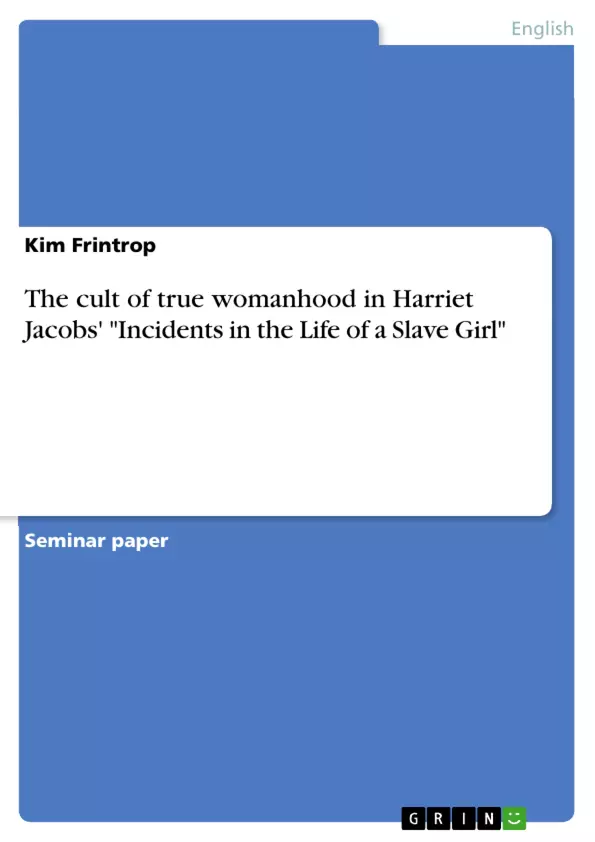Incidents in the Life of a Slave Girl by Harriet Jacobs is a narrative which is much more than a typical antebellum slave narrative since it can be characterized as a public document which provides an insight into the spirit, psyche and history of an African American slave woman who fights for an antislavery reform (Sánchez-Eppler 83). Incidents covers many topics such as the brutal and ruthless behavior of the white middle-class towards African American slaves, the peculiar institution and the strong familiar coherence based on female slaves. Another very significant topic, which is covered with high importance throughout the autobiography, is the image of the woman during the nineteenth century in the United States. The ideal of an American true woman during the antebellum period was coined by four cardinal virtues of the Victorian Age: piety, purity, domesticity and submissiveness. Further research of Jacobs’ autobiography proves that neither white female middle and upper class women nor African American female slaves are able to meet all the standards of a true woman due to the institution of slavery. To prove the statement above, I will initially explain what was meant by the ideology of true womanhood during the mid-nineteenth century in America. Then the paper will transfer the principles of true womanhood to the protagonist’s living conditions and to other important female characters such as Mrs. Flint, Aunt Marthy and Mrs. Bruce. Concerning this matter, it is important to mention that the narrator Linda Brent and the author Harriet Jacobs are the same in the autobiography because Jacobs has given persons fictitious names in order to protect their identities. Harriet Jacobs’ name will be used when talking about the author, but her pseudonym Linda Brent will be used with regard to the protagonist.
Table of Contents
- Introduction
- The Cult of True Womanhood
- Analysis
- Linda Brent
- Mrs. Flint
- Aunt Marthy
- Mrs. Bruce
- Conclusion
Objectives and Key Themes
This work analyzes Harriet Jacobs' Incidents in the Life of a Slave Girl, examining how the protagonist, Linda Brent, navigates the oppressive institution of slavery and challenges the prevailing ideology of "true womanhood" in the antebellum South.
- The impact of the "true womanhood" ideal on both white and African American women in the antebellum era
- The ways in which slavery undermines the principles of "true womanhood" for female slaves
- The interplay between religion and morality in the context of slavery
- The complex experience of motherhood for slave women
- The strategies employed by Linda Brent to resist both slavery and the expectations of "true womanhood"
Chapter Summaries
- Introduction: This chapter introduces the reader to Incidents in the Life of a Slave Girl as a unique and important narrative. It highlights the central theme of the "true womanhood" ideal and its impact on both white and African American women in the antebellum South.
- The Cult of True Womanhood: This chapter delves into the concept of "true womanhood" during the antebellum period, outlining its four cardinal virtues: piety, purity, domesticity, and submissiveness. It explores how this ideology was primarily a middle and upper-class construct, with African American female slaves facing significant obstacles in achieving this status.
- Analysis: This section examines how the protagonist, Linda Brent, navigates the contradictions between her experiences as a slave and the prevailing expectations of "true womanhood." It highlights the challenges she encounters with regard to piety, domesticity, purity, and submissiveness, showcasing her resilience in the face of oppression.
Keywords
Key themes and concepts explored in this work include "true womanhood," antebellum society, slavery, African American women, domesticity, piety, purity, submissiveness, resistance, motherhood, and the intersection of race and gender.
- Arbeit zitieren
- Kim Frintrop (Autor:in), 2014, The cult of true womanhood in Harriet Jacobs' "Incidents in the Life of a Slave Girl", München, GRIN Verlag, https://www.grin.com/document/280147



